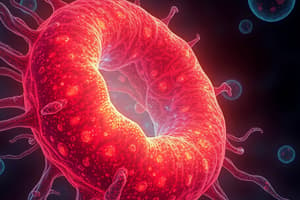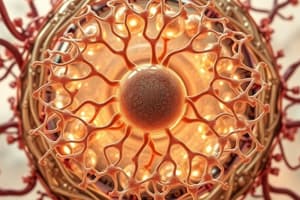Podcast
Questions and Answers
What are the two defining characteristics of stem cells?
What are the two defining characteristics of stem cells?
- Apoptosis and regeneration
- Multipotency and totipotency
- Self-renewal and differentiation (correct)
- Metabolism and specialization
Which type of stem cells is considered totipotent?
Which type of stem cells is considered totipotent?
- Mesenchymal stem cells
- Adult stem cells
- Embryonal stem cells (correct)
- Hematopoietic stem cells
What is the primary function of the three germinal layers formed during early embryonic development?
What is the primary function of the three germinal layers formed during early embryonic development?
- To differentiate into various tissues and organs (correct)
- To provide structural support to the embryo
- To regulate immune responses
- To facilitate nutrient absorption
Which statement best describes trans-differentiation across germinal layers?
Which statement best describes trans-differentiation across germinal layers?
How does Cell Theory apply to the concept of stem cells?
How does Cell Theory apply to the concept of stem cells?
What is the primary function of epithelial tissue?
What is the primary function of epithelial tissue?
Which tissue type is responsible for voluntary body movements?
Which tissue type is responsible for voluntary body movements?
What characterizes connective tissue in terms of physical properties?
What characterizes connective tissue in terms of physical properties?
How do the functions of organs arise from tissue organization?
How do the functions of organs arise from tissue organization?
Which tissue is primarily involved in the transmission of nerve impulses?
Which tissue is primarily involved in the transmission of nerve impulses?
Which of the following properties indicates the ability of a tissue to return to its original shape after deformation?
Which of the following properties indicates the ability of a tissue to return to its original shape after deformation?
What is the primary cell type associated with muscle tissue?
What is the primary cell type associated with muscle tissue?
Which type of tissue has a very small amount of extracellular matrix?
Which type of tissue has a very small amount of extracellular matrix?
Flashcards are hidden until you start studying
Study Notes
Cell Theory and Stem Cell Theory
- Cells originate from other cells, inheriting the same genetic information.
- Stem cells have two defining characteristics: self-renewal and differentiation.
- Self-renewal allows stem cells to replicate, creating identical copies.
- Differentiation involves epigenetic changes, leading to specialized behaviors in stem cells.
- Embryonic stem cells are the only truly totipotent stem cells, meaning they can differentiate into any cell type.
- Differentiation progresses to pluripotent stem cells, such as mesenchymal and hematopoietic, which have more limited differentiation potentials.
Embryological Origin of Cell Types
- The three primary germ layers formed during early development are ectoderm, mesoderm, and endoderm.
- These germ layers give rise to different cell types and organs.
- Trans-differentiation, the transformation of one cell type into another across germ layers, is not a naturally occurring process but a subject of active research.
Tissue Types
- Epithelial tissue: Composed of closely packed cells with minimal extracellular matrix.
- Functions: Lining of surfaces, body cavities, glandular secretion.
- Connective tissue: Contains various fixed and wandering cells embedded in an abundant extracellular matrix.
- Functions: Support and protection of tissues and organs.
- Muscle tissue: Contains elongated, contractile cells with moderate extracellular matrix.
- Functions: Strong contraction, body movements.
- Nervous tissue: Composed of elongated cells with extremely fine processes and very minimal extracellular matrix.
- Functions: Transmission of nerve impulses.
Levels of Organization
- The term "tissue" can refer to both simple (histological) and compound tissues.
- Organs are distinct groups of tissues that work together to perform a specific function.
- Organs integrate simple tissue functions to create complex, higher-level functions.
Organ Function from Organization
- The intestine is an example of how multiple tissues work together.
- Ciliated columnar epithelium separates the food compartment and facilitates absorption.
- Connective tissue provides shape, structure, and space within the intestine.
- Smooth muscle tissue enables food motility.
- Vascular tissues are responsible for nutrient transport.
Physical Properties of Tissues
- Strength: Maximum stress a tissue can withstand before failure (tearing).
- Toughness: Ability to absorb energy and prevent fracture.
- Elasticity: Ability and force to return to its original shape.
Studying That Suits You
Use AI to generate personalized quizzes and flashcards to suit your learning preferences.




